Welcome to the Jungle: An Overview of Jungle Monsters in League of Legends
Bushwhack your way through the jungle with this handy guide!
Bushwhack your way through the jungle with this handy guide!
Among the five roles in League of Legends, jungling is perhaps the most different. While the others are all bound to a lane and are almost constantly near their opponent, the jungler can freely roam the map and is always attempting to only meet the other jungler on favourable terms for themselves. Beyond this, the monsters in the jungle are much different than the countless waves of minions that laners face, and all of them are unique in their own way. This guide will look at the differences between the non-epic monsters that populate the jungle and explain why these differences are relevant, hopefully helping you gain a better understanding of the fundamentals of jungling.

While monsters are all different in their own right – some are ranged and some are melee, some are large and others are small, etc. – they all share some common traits. With the exception of the Rift Scuttler, all monsters are stationary and will not move unless attacked by a champion. Once attacked, they will move towards and attack the nearest enemy champion. The extent to which they will chase this champion away from their spawn point is indicated by their Patience bar. If this bar, which is displayed below their health, becomes depleted, they will move quickly towards their spawn point and begin rapidly healing. Unlike minions, monsters will not stop attacking a champion if they move into a bush.
Another trait that is shared by all medium, large, and epic monsters is that they can be targeted by the summoner spell Smite. Smiting jungle monsters serves two key purposes: it does an immense amount of true damage to them, and it heals the individual who casted it upon the monster. While the latter of these purposes is helpful in an obvious way, as healing is almost always a good thing, the former is important specifically within the context of jungling. Since Smiting a monster deals hundreds of points of damage instantaneously, this summoner spell can be used to secure the kill against a monster if enemies are also trying to kill it.
All non-epic monsters level up as the game progresses, just like champions do, but they do it in a much different way. Each time a jungle monster dies and respawns, it levels up, increasing its health and attack damage, along with sometimes altering the gold or experience granted upon slaying it. Obviously, this means that slaying a camp of jungle monsters becomes harder as the game progresses, assuming that all of the monsters are being slain on a regular basis. Throughout this guide, sometimes the stats that a monster has or the rewards that it grants will be listed as a range rather than a finite number. As might be intuitive, this is meant to indicate that the monster changes as it dies, respawns, and levels up.
A Note About Kiting: Later in this guide, the term ‘kiting’ is used several times. For newer players, kiting refers to the action of attacking an opponent while moving away from them. If this were a guide exclusively about jungling effectively, this mechanic would be emphasized more heavily, as it is the key to clearing the jungle while remaining healthy. For the purposes of this guide, all that you need to know is that kiting is a way to reduce the damage taken while fighting monsters, and that slow-moving, melee attacking monsters such as the Red Brambleback and the Blue Sentinel are the easiest to kite.
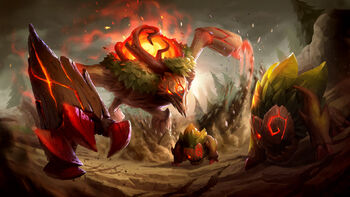
Health: 1800-3150
Attack Damage: 82-303
Attack Speed: 0.493
Armor: 20
Magic Resistance: 20
Movement Speed: 275
Monster Type: Large
Respawn Timer: 5 minutes
Rewards for Slaying: 100 gold, 120-148.5 experience, and the Crest of Cinders.
Notes and Advice: More commonly known as ‘Red Buff’, this large jungle monster is one of two options that most junglers start with. The buff that it grants for being slain – the Crest of Cinders – grants health regeneration and makes the holder’s attacks apply both a slow and a burn. As such, junglers who are not heavily reliant on mana for their early clear tend to slay this monster first so that they can clear quickly and healthily.
While there isn’t much advice to be given regarding slaying this monster, as it is relatively straightforward in comparison to other camps, there is much that can be said about the Crest of Cinders. Ganking a lane while you have this buff can be incredibly effective, as the slow and extra damage dealt by the burn increase your ability to secure to kills on enemy laners. However, it is also important to play somewhat cautiously when you have this buff, as if you are slain by an enemy champion while you have it, the enemy champion will steal it. Given the long respawn timer on this camp, losing this buff to the enemy team can be disastrous, so ensuring that it stays within your team is incredibly important. Later in the game, offering the bot-laner this buff can be the most efficient way to use it, as they are attacking the most often and thus can apply the slow and burn with ease.

Health: 1800-3150
Attack Damage: 82-303
Attack Speed: 0.493
Armor: 20
Magic Resistance: 20
Movement Speed: 275
Monster Type: Large
Respawn Timer: 5 minutes
Rewards for Slaying: 100 gold, 120-148.5 experience, and the Crest of Insight.
Notes and Advice: More commonly known as ‘Blue Buff’, this jungle monster is the alternative starting point for junglers. Since the buff that it grants for being slain – the Crest of Insight – provides increased mana restoration and cooldown reduction to the holder, junglers that rely on spellcasting for early jungle clearing and ganking tend to start by slaying this monster.
Outwardly, it is perhaps easy to notice that this monster is identical to its crimson counterpart, having all of the same stats and rewards save for the Crest that it provides. As a result, most of what can be said here is just echoing the above: slaying this monster is straightforward and make sure to not lose its buff to the enemy team. However, one notable statement to be made is that you should not underestimate the kill potential that having more mana and lower cooldowns can bring about in the early game. Being able to use your abilities more often can ensure that a kill which would otherwise slip away can be obtained relatively easily. As the game progresses, passing this buff off to your mid-laner is also a relatively common (and effective) strategy.
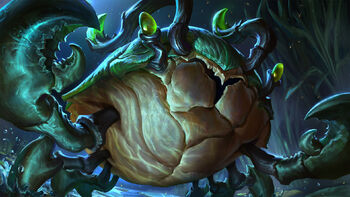
Health: 1000-2066
Attack Damage: 35-116
Attack Speed: 0.638
Armor: 20
Magic Resistance: 20
Movement Speed: 155
Monster Type: Large
Respawn Timer: 2 minutes and 30 seconds
Rewards for Slaying: 70-126 gold, 115-207 experience, and a Speed Shrine.
Notes and Advice: The Rift Scuttler is perhaps the most unique and most contested of the non-epic jungle camps, wandering in the river between the two sides of the rift. The Speed Shrine that spawns as a result of slaying it, which both grants vision and creates an area that temporarily increases the movement speed of allies who stand in it, means that both teams often scramble to slay this monster whenever it spawns.
In terms of slaying it, it is important to remember two things: that it is shielded for 60% of its maximum health whenever it spawns, and that this shield is destroyed when the Rift Scuttler is hit with certain disables. Whether this means silencing it, immobilizing it, or otherwise controlling its actions, breaking this shield is crucial to defeating it as quickly as possible. It is also relevant to note that, despite having Attack Damage and Attack Speed as listed stats, this monster cannot attack and instead moves away from the champion attacking it.
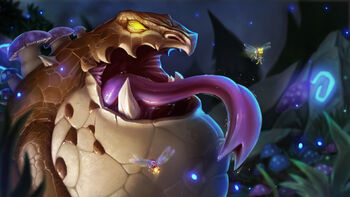
Health: 1650-2640
Attack Damage: 80-253
Attack Speed: 0.425
Attack Range: 250
Armor: 20
Magic Resistance: 20
Movement Speed: 330
Monster Type: Large
Respawn Timer: 2 minutes
Rewards for Slaying: 105 gold, 135-182.25 experience, along with restoring an amount of health and mana that increases based on your missing health and mana.
Notes and Advice: Although Gromp has ‘Attack Damage’ listed as one of its stats, its basic attacks actually deal magic damage. It is also the first monster on this list that attacks from range, making it extra dangerous in the sense that kiting it is more difficult than with other monsters.
Like most of the monsters that will follow, there isn’t much to say about slaying Gromp that isn’t intuitive. Just like the Red Brambleback and Blue Sentinel, it is relatively straightforward. Perhaps the most important thing to note that since its attacks deal magic damage, champions with low magic resistance will struggle to fight it in the early game. However, this is often counteracted by the health and mana that it provides when slain, meaning that champions who take more damage from Gromp ultimately heal more once they prevail in slaying it.
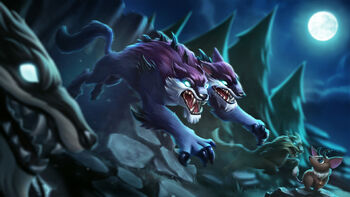
Health: 1200-2200 (Greater), 480-888 (Normal)
Attack Damage: 42-155 (Greater), 16-59 (Normal)
Attack Speed: 0.625
Armor: 20 (Greater), 0 (Normal)
Magic Resistance: 20 (Greater), 0 (Normal)
Movement Speed: 525
Monster Type: Large (Greater), Small (Normal)
Respawn Timer: 2 minutes
Rewards for Slaying: 55 gold and 65-87.75 experience (Greater), 15 gold and 15-20.25 experience (Normal).
Notes and Advice: With each camp containing one Greater Murk Wolf and two normal Murk Wolves, this is the first camp on this list that features multiple monsters. Given that these monsters are also the fastest moving of the ones on this list, this means that kiting this camp is next to impossible for a melee champion.
In terms of slaying these monsters, it is advisable to kill the normal Murk Wolves before the Greater one since the normal wolves will die much faster than the Greater Murk Wolf. Since the smaller wolves have just over a third of the larger wolf’s health and zero resistances, they will die over three times as quickly and thus will no longer be able to apply the small-but-noticeable amount of damage that they deal. Furthermore, this camp is the first camp to feature a monster that cannot be Smote (the regular Murk Wolves, since they are considered ‘small’ monsters), so leaving the Greater Murk Wolf for last means that you can smite it and heal at the end of slaying it.
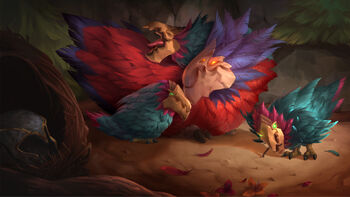
Health: 800-1760 (Crimson), 425-723 (Normal)
Attack Damage: 20-74 (Crimson), 13.33-56.33 (Normal)
Attack Speed: 0.667 (Crimson), 1.000 (Normal)
Attack Range: 300
Armor: 20 (Crimson), 0 (Normal)
Magic Resistance: 20 (Crimson), 0 (Normal)
Movement Speed: 450 (Crimson), 525 (Normal)
Monster Type: Large (Crimson), Small (Normal)
Respawn Timer: 2 minutes
Rewards for Slaying: 45 gold and 45-60.75 experience (Crimson), 8 gold and 10-13.5 experience (Normal).
Notes and Advice: Another camp containing multiple monsters, this camp will always spawn one Crimson Raptor and five normal Raptors. These monsters notably have the highest attack range of any monster on this list, and the smaller Raptors are tied with the Murk Wolves for being the fastest monsters as well.
When slaying this camp of monsters, it is advisable to slay the smaller Raptors as quickly as possible. A bit of math would show that since they attack faster and only deal slightly less damage, they will overtake the Crimson Raptor in damage over the course of a few seconds. Slaying these smaller monsters first is enabled by the fact that they have zero armor or magic resistance, meaning that killing them is significantly easier than slaying their larger counterpart. Just as with the wolves, the smaller Raptors are not Smiteable, something that is important to keep in mind.
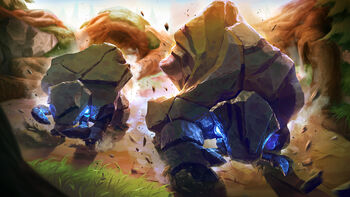
Health: 1050-1785 (Ancient), 500-875 (Normal), 60-105 (Mini)
Attack Damage: 80-296 (Ancient), 25-93 (Normal), 17-60 (Mini)
Attack Speed: 0.613
Armor: 20 (Ancient), 0 (Normal and Mini)
Magic Resistance: 20 (Ancient), 0 (Normal and Mini)
Movement Speed: 250 (Ancient), 350 (Normal), 400 (Mini)
Monster Type: Large (Ancient), Medium (Normal), Small (Mini)
Respawn Timer: 2 minutes
Rewards for Slaying: 42 gold and 37-49.95 experience (Ancient), 7 gold and 10-13.5 experience (Normal), 12 gold and 18-24.3 experience (Mini).
Notes and Advice: While this multi-monster camp starts with just one Ancient Krug and one Krug, each of these splits in two of the version below it when slain (the Ancient Krug splits into two Krugs, which split into two Mini Krugs each). As a result, although this camp only starts with two monsters, it actually has the most monsters out of any camp in the game.
While slaying these monsters is a relatively straightforward task, it is notable that you should always try to slay the Mini Krugs instead of just walking away after defeating the regular Krugs. As you might have noticed from reading the above, Mini Krugs actually give more gold and experience than the regular-sized Krugs do. Unless you are counter-jungling and want to make it so that the camp’s respawn timer does not start, it is always advisable to slay each and every Krug in this camp, from the tallest to the smallest.
If you take one key idea away from this guide, it should be that each monster is unique in its own way. While one can jungle by just facetanking each monster and basic attacking it until it’s dead, a smoother and healthier clear involves kiting the slower monsters. Of course, this can only be done if you know which monsters are slow enough to kite, like the Red Brambleback or Blue Sentinel, and which ones are un-kiteable for melee champions, like the fast Murk Wolves or the ranged Gromp. While the jungle can seem scary and intimidating at first glance, having knowledge is the key to jungling effectively. If this is your first step into learning about jungling, then welcome to the jungle.